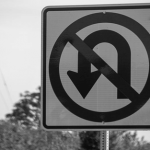Even with the time change coming up on November 7th (remember to turn your clocks back an hour), in North Dakota it gets dark very early in the evening during the winter months. This limits all drivers’ ability to see past their headlights, and creates other hazards not as prevalent in daylight driving. When driving a semi, it takes longer to stop for emergency traffic situations, requiring additional safety measures be taken by semi drivers to prevent tragic crashes. Let’s explore those safety measures meant to prevent catastrophic night crashes involving semis.
Federal Law
Federal law requires that all commercial drivers license (“CDL”) drivers and applicants for a CDL license possess and demonstrate a list of safe on-road driving skills. For CDL drivers, 49 C.F.R. 383.111 lists 20 general areas that all commercial motor vehicle (“CMV”) drivers must know. For this blog, #11 is the most applicable, which states:
- (11) Night operation. Preparation and procedures for night driving, including:
- (i) Night driving factors, e.g., driver factors (vision, glare, fatigue, inexperience);
- (ii) Roadway factors (low illumination, variation in illumination, unfamiliarity with roads, other road users, especially drivers exhibiting erratic or improper driving); and
- (iii) Vehicle factors (headlights, auxiliary lights, turn signals, windshields and mirrors).
North Dakota CDL Manual Training
As has been talked about on this blog before, the North Dakota CDL Manual is the study guide for drivers to know prior to taking their CDL driving test. The North Dakota CDL Manual is created in part to make sure that Federal Law requiring minimum standards for safe operation of a CMV are being met. 49 C.F.R. 383.113 sets forth a whole list of safety skills CDL applicants need to possess, which are then taught through the CDL Manual. These include knowledge of visibility conditions, which would include darkness from night driving.
Section 2 of the North Dakota CDL Manual deals with driving safely. Specifically, Section 2.11 is titled “Driving at Night”, and the very first subsection 2.11.1 is clear in its title “It’s More Dangerous”, and lists the problems of night driving involve (1) the driver, (2) the roadway, and (3) the vehicle. It’s no mistake that these are the same things listed in 49 C.F.R. 383.111 section 11 discussed above. Let’s look at each of these separately.
Driver Issues In Night Driving
Section 2.11.2 lists three separate driver factors to consider related to night driving: (1) vision, (2) glare, and (3) fatigue/lack of alertness.
For vision, the analogy provided is walking into a dark movie theater, where you can’t see as sharply and your eyes need time to adjust to seeing somewhat better in that situation. It seems obvious, but the vision of semi drivers is affected by the darkness and dim lighting available.
For glare, the manual says the older the driver, the more effect the glare can have on a driver. Glare can come from other vehicle lights, and it can take several seconds to recover from glare. At 55 mph, even 2 seconds of vision being affected by glare means the semi has traveled more than half a football field. That’s a lot of distance for a semi driver to be blinded when every foot counts.
For fatigue/lack of alertness, the manual is clear that people are less alert at night. It’s just how humans are wired, especially after midnight. The manual is clear that if the driver is sleepy, the only safe cure is to get off the road and get some sleep, and if they don’t, they risk their own life and the lives of others on the road.
Roadway Issues In Night Driving
Two roadway factors are discussed dealing with (1) poor lighting, and (2) drunk drivers.
For poor lighting, the lighting varies greatly depending on where the driver is driving (i.e., city vs. rural roads). Most of the time, the driver has to rely entirely on their headlights. Since there is less light, the drivers are not able to see the hazards as well and as early as in daytime. The manual is clear; the driver needs to drive slowly enough to be sure they can stop in the distance they can see ahead while driving at night.
The manual also warns semi drivers to watch out for drunk drivers at night, especially around closing times for bars. Specifically, the manual tells semi drivers to watch for drivers having trouble staying in their lane, maintaining speed, who stop without reason, or show any other signs of being under the influence. It may seem backwards that the manual is telling the semi driver to watch out for impaired drivers, but that is how serious safety measures need to be when dealing with semis. Because they share the road with all drivers, all foreseeable situations need to be watched out for when driving a semi, even if the other driver is drunk, to prevent catastrophic crashes with a semi, even with an impaired driver.
Vehicle Factors In Night Driving
There are four areas related to vehicle factors discussed in Section 2.11.4: (1) headlights, (2) other lights, (3) turn signals and brake lights, and (4) windshield and mirrors.
For headlights, once again the manual reiterates that the headlights of the semi will usually be the main source of light for the driver to see, and for other people to see the semi. With low beams the driver can see about 250 feet, and with high beams they can see about 350-500 feet. The manual is clear, “You must adjust your speed to keep your stopping distance within your sight distance”, which “means going slowly enough to be able to stop within the range of your headlights.” “Otherwise, by the time you [semi driver] see a hazard, you will not have enough time to stop.” As discussed in prior blog articles, when a semi can’t stop, the crash is almost always fatal or creates catastrophic injuries for the drivers and passengers in regular cars/SUVs or pickups. The manual also requires that other lights must be clean and working properly, such as reflectors, marker lights, clearance lights, taillights, and identification lights.
As for turn signals and brake lights, the manual is clear that at night these signals are even more important to tell other drivers what the semi intends to do. Therefore, the driver needs to make sure they have clean, working turn signals and stop lights.
At night, it is more important for a semi to have a clean windshield and mirrors, as bright lights at night can cause glare and block the view of the driver. The manual states windshields on the inside and outside be cleaned for safe driving at night.
Night Driving Procedures
The CDL Manual in section 2.11.5 provides night driving procedures for drivers of semis. This section states that semi drivers need to make sure they are rested and alert, do a full pre trip inspection (as is always required) to specifically look to check on lights and reflectors, avoid blinding other drivers, avoid glare from oncoming traffic by not looking directly at the lights, use high beams when the driver can, and don’t let the lighting in the cab get too bright. One final emphasis is placed on drivers making sure they stop driving if sleepy. Specifically, the manual states:
- If you look sleepy, or you just feel sleepy, stop driving! You are in a very dangerous condition. The only safe cure is to sleep.
Conclusion
While night driving is more dangerous for all drivers, this is especially true for drivers operating semis that can weigh in excess of 40 tons. That is why there are special safety measures for semi drivers to follow when driving at night, which during the winter in North Dakota is most of the time during a day.
This area of the law is highly technical and it is important you have an attorney who understands the huge difference between a regular car crash and one involving a commercial motor vehicle. If you or a loved one has been catastrophically injured or killed in a crash involving a commercial motor vehicle, it is very important you hire an attorney who knows trucking law and regulations. Our personal injury team at SW&L Attorneys understands, knows, and handles all trucking and commercial motor vehicle accidents. To get in touch with our team, call 701-297-2890, or email info@swlattorneys.com.










